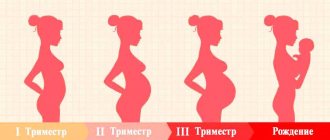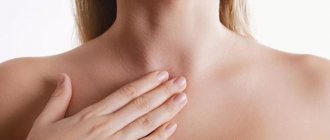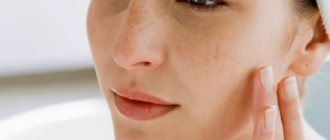Often, experienced obstetricians and gynecologists can tell that a patient is pregnant without resorting to an examination or special laboratory tests—the first glance at the woman is enough for them. This data cannot be included in the documentation, but you can notice these changes yourself by looking at yourself in the mirror.
During the period of bearing a baby, all the activities of the expectant mother’s body are aimed at ensuring normal growth of the fetus and maintaining the necessary conditions that ensure its development according to a genetically encoded plan. Pregnancy affects the functioning of all systems of the mother’s body: endocrine, nervous, cardiovascular, respiratory, digestive, immune, urinary; The condition of the skin, hair and nails also changes.
How does the skin of an expectant mother change?
Often during pregnancy, the production of melanin (a special pigment, the amount of which determines skin color) increases. Melanin is predominantly deposited on the face, nipples, areola, and midline of the abdomen. This is due to changes in the function of the adrenal glands: during this period they produce more hormones (mineralocorticoids and glucocorticoids), which regulate the formation of brown pigment. Melanin deposition is further increased by exposure to ultraviolet rays, so the appearance of small brown spots - chloasma - on the skin of the forehead, cheekbones and upper lip not only depends on increased melanin production, but is also a consequence of increased skin sensitivity to ultraviolet rays. Therefore, if you protect your skin from ultraviolet rays using protective creams or a hat, you can avoid the appearance of age spots. Chloasma generally goes away after pregnancy, as do other types of pigmentation, such as pigmentation of the midline of the abdomen and nipple areolas.
In the second trimester of pregnancy, hormones are produced that promote active growth of the fetus; these same hormones can contribute to the enlargement of previously existing pigmented nevi (moles). If itching occurs in the area of the pigmented nevus, bleeding appears, or hair falls out, you should immediately consult a dermatologist.
The skin feels dense and elastic to the touch. These qualities depend on the presence of elastic and collagen fibers in it. The quantity and quality of these fibers are genetically inherited; this trait determines the possibility of stretch marks. Stretch marks (pregnancy scars) are small red stripes on the chest, abdomen, buttocks and thighs. Stretch marks can appear on the chest from the second month of pregnancy, when the mass of the mammary glands rapidly increases, and on the abdomen and buttocks - by the end of the fourth month of pregnancy, when the abdomen begins to enlarge and an intensive increase in body weight occurs. Pregnancy scars are formed as a result of the rupture of collagen and elastin fibers in the skin. A connective tissue scar forms at the site of the rupture. After childbirth, the scars lose their pink color and take on the appearance of white stripes. During subsequent pregnancies, new scars may appear against the background of old ones, having a characteristic pink color.
Female sex hormones regulate the secretory activity of the sebaceous and sweat glands and the formation of horny scales. Outside of pregnancy, sebum and sweat are produced in sufficient quantities. The sebum that comes to the surface of the skin creates an acidic, water-fat film on it, together with sweat, called the “acid mantle” of the skin. The indicator of the environment of this mantle in healthy skin, i.e. the acid-base indicator (pH) is 5.5-6.5; this indicates that the skin has an acidic environment. Traditionally, it is believed that the mantle will create a protective barrier for microbes to penetrate the skin.
During pregnancy, female sex hormones are produced in such a way that the amount of progesterone, the hormone that maintains pregnancy, exceeds the amount of estrogen, the sex hormones that, among other things, regulate the production of the skin garden. Due to the decrease in the amount of estrogen, the sebaceous and sweat glands work less intensely, while normal or dry skin becomes drier and itching appears. The skin becomes easily inflamed, causing so-called pregnancy dermatitis. In women who had oily skin before pregnancy, on the contrary, the functioning of the sebaceous and sweat glands is normalized.
Due to changes in hormonal levels during pregnancy, fat cells are redistributed, hips become more rounded, and fatty tissue is deposited on the abdomen. These changes are another factor that protects pregnancy; in this case, adipose tissue serves as a mechanical protection for the uterus.
During pregnancy, especially in the second half, due to changes in hormonal levels and blood circulation characteristics, a tendency to fluid retention appears. This cannot but affect the condition of subcutaneous fat and skin. In this regard, it is appropriate to mention that the first stage of skin changes due to cellulite is the retention of excess water in it, so this condition is likely to occur during pregnancy. This is especially true in the second half of pregnancy, when the weekly gain is 250-300 g. With a more significant rate of increase in body weight, we can talk first about hidden, and then about obvious edema (preeclampsia). Throughout pregnancy, a woman’s body weight increases on average by 9-12 kg, depending on her constitution.
Rashes
Sometimes pregnancy presents not the most pleasant surprises in the form of various skin rashes. It can be:
Acne (acne)
Appears against the background of altered hormonal levels. Do not try to cleanse the skin yourself using deep cleansing, steaming, etc. During pregnancy, it is better to use gentle oils that gently cleanse the skin. Your body now needs increased amounts of vitamins A and E (you can take them in combination - for example, in the drug "Aevit"), but you should first consult with a gynecologist.
Rash in skin folds
This unpleasant phenomenon is often accompanied by redness and itching. Pay attention to underwear - it should be made of pure cotton. Try to ventilate your skin more often so that it can breathe freely. You can lubricate the areas of the rash with diluted lemon juice - this also helps to cope with the rash.
Vitamins A and D will help cope with itching (most often it appears in the sacral area, but sometimes it occurs throughout the body). Add olive oil to your diet, do not forget about carrots, yolks, fatty varieties of sea fish, orange vegetables and fruits, sprouted wheat and nuts. Castor oil can be applied to itchy areas.
Hair during pregnancy
Hair is 3% water and 97% protein keratin, enriched with sulfur, microelements (iron, copper, zinc, chromium, manganese) and vitamins.
An adult has about 100,000 hairs, and the number depends on the color. Redheads have the thickest hair, but less hair than brunettes. Blondes have the most hair - approximately 150,000. Black hair is the largest of all, it can be 3 times thicker than blond hair. Hair also grows differently. Their length increases most quickly on the head (in 3 days - about 1 mm), and slowest on the eyebrows.
An individual hair lives on average from several months to 6 years. Eyelashes live from 3 to 5 months, vellus hair covering the body - 7-10 months. It is considered normal if 30 to 50 stripes fall on your head per day. As the hair grows, the cells of the bulb become keratinized, and the bulb turns into a hair flask, similar to an inverted fir cone.
The process of stripe loss lasts 60-90 days. If there is a spike at the end of a lost hair, this indicates a normal type of hair loss and that the hair is healthy. If, when the strip is pulled out, there is a division or notch at the root, it means that the hair is pathologically altered. Such hair is brittle, grows poorly, and breaks off when it appears on the surface of the skin.
The flask-shaped hair falls out during physiological hair change, and in its place new hair grows from the remaining papilla or the newly formed papilla and bulb. In case of hair diseases, this process is absent, and the hair falls out completely.
Healthy hair that grows is usually strong and resilient. The hair can be stretched to 1/5 of its length, and after that it returns to its original state. The strength of hair is comparable to aluminum and can withstand a load of 100 to 200 g. The hair on the head is not just decoration - it performs important functions, protecting the head from overheating and hypothermia. Vellus hair is involved in the sense of touch, eyelashes protect the eyes, and hair in the nose and ears traps dust.
Thanks to the action of progesterone during pregnancy, hair growth accelerates and the process of natural hair loss is delayed. During this period, hair usually retains a healthy appearance, shine and thickness. In some cases, during pregnancy, hair growth is observed on the skin of the face, abdomen and thighs, which is due to increased production of androgens by the adrenal glands and partly by the placenta. Hypertrichosis (hair growth) is temporary and gradually disappears after childbirth. Hair that was oily before pregnancy may become drier. Immediately after childbirth, the hormonal background changes sharply: there is less estrogen and progesterone, while estrogens, which ensure contractile processes in the uterus, predominate. The hormone prolactin is actively released, which ensures lactation. All these changes lead to the fact that the hair that was luxurious during pregnancy begins to fall out immediately after childbirth, and the young mother begins to feel that her full head of hair may disappear completely. Fortunately, this is not the case. During the first three to six months after giving birth, all the hair that should have fallen out during pregnancy falls out. New ones sometimes grow slowly, so the hair appears much thinner than usual. By the end of your baby's first year, your hair should be as thick as it was before pregnancy.
Should you report your symptoms to your doctor?
Any change in condition during pregnancy should not be overlooked. It is imperative to inform your doctor about dry skin, despite the fact that this is a common occurrence for a pregnant woman. He will identify the cause and prescribe methods to eliminate it, which may include:
- change in the amount of fluid consumed;
- nutrition correction;
- taking vitamin complexes;
- use of special creams and other cosmetics.
Dryness is caused not only by the listed reasons, but also by some diseases or allergic reactions. The doctor must conduct an examination to promptly detect and eliminate them. A missed allergy can be passed on to the child.
Nails during pregnancy
Nails are just a layer of dead keratin (which is also part of our hair). Their purpose is to protect delicate fingertips. The nail bed is supplied with oxygenated blood through a well-developed capillary system located under the nail bed. Nails do not need vitamins and minerals, since they consist of dead protein, and therefore their growth cannot be enhanced with the help of these substances. On the other hand, protein deficiency will affect the condition of your nails. However, most people consume 3-4 times more protein than their body needs. Nails grow at a rate of 3-6 mm per month, depending on the age and health of the person. Their growth occurs faster at a young age and in warm climates. An interesting fact is that the nails on the right hand (or, if you are left-handed, then on the left) grow faster. Nails on the middle fingers also grow faster than others. This is due to the fact that functionally more active fingers are better supplied with blood, and therefore with nutrients. Just as in the case of hair, increased hormonal activity during pregnancy has a positive effect on the condition of the nails. They grow faster, become harder, stronger and more beautiful.
Fortunately (or maybe, on the contrary, unfortunately), almost all the metamorphoses that will happen to your appearance during pregnancy are temporary. It will take your body about six months to return to its “original position” after the birth of your baby. And then, looking in the mirror, you will again see yourself as you were before - with the exception of a new, “motherly” expression in the eyes, which will remain with you for the rest of your life.
Skin structure
Our code is very complex. It consists of three layers: the epidermis, the skin itself, or dermis, and subcutaneous fat. Each of them, in turn, also consists of several layers. The thickness of the skin ranges from 0.5 to 4 mm and depends mainly on the size of the dermal (middle) layer. It is relatively less pronounced on the face and more noticeable on the hips.
The epidermis has the appearance of a narrow strip, its thickness can range from 0.07 to 0.12 mm; consists of five layers. The epidermis contains epithelial cells that have a varied structure and arrangement. In its lowest layer, the germinal, or basal, cells constantly multiply. Gradually moving towards the surface of the epidermis, its cells change their structure. Thus, the cells of the basal layer contain fairly large nuclei, while the cells of the most superficial, stratum corneum are devoid of nuclei. The cells of this layer peel off easily. The stratum corneum is dense, elastic, poorly conducts the body and electricity and protects the skin from injury, burns, cold, moisture, and chemicals. Between the stratum basale and the stratum corneum are the stratum spinosum, stratum granulosum and stratum lucidum.
The skin itself (dermis) consists of two layers, papillary and reticular. It contains fibers, including collagen and elastic, that make up the framework of the skin. In the papillary layer the fibers are softer and thinner; in the mesh they form denser bundles. The reticular layer of the skin contains sweat, sebaceous glands and hair.
Subcutaneous fatty tissue in different parts of the body has unequal thickness: on the stomach, buttocks, and palms it is well developed; on the ears and the red border of the lips it is very weakly expressed. In obese people, the skin is inactive; in thin and emaciated people, it easily shifts. Fat reserves are deposited in the subcutaneous tissue, which are used up during illness or other unfavorable cases. It protects the body from bruises and hypothermia. In your own skin and subcutaneous tissue there are blood and lymphatic vessels, nerve endings, hair follicles, sweat and sebaceous glands, and muscles.







